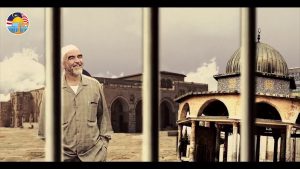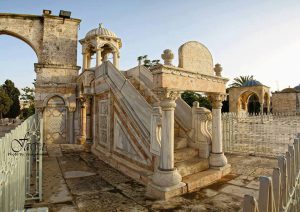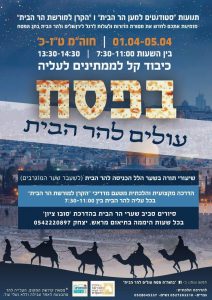A large number of doors and giant gates were opened in the walls of al-Aqsa Mosque. The number reached 14 gates to suit the needs of the residents and the visitors coming from different directions. Currently, these gates can be divided into two sections:
Opened Gates: 10 gates
Closed Gates: 4 gates
These gates are distributed on the four sides of the wall of al-Aqsa Mosque in its four directions as follows:
Eastern part: two gates
Northern part: three gates
Western part: seven gates
Southern part: two gates
The gates in both sides of the eastern and southern parts are closed; the reasons are explained in detail below. It is also noticed that most of the opened gates are located in the western side (7 gates). Unfortunately, the Zionist occupation army controls the entry of Muslim worshipers to al-Aqsa Mosque through the checkpoints which set up in front of these gates along with full control of the Moroccan Gate used by settlers and extremists to break into al-Aqsa Mosque.
Open Gates
1) The Tribes Gate
The Tribes Gate was built in 610 AH/1213 AC, and is a four meters high arched gate located on the Northeast side of the Al-Aqsa Mosque. It was renovated several times; however, the current door was renovated by the Ottoman Sultan Suleiman the Magnificent. This gate is also called “Virgin Mary’s Gate” because of its close location to Saint Hannah Church where Christians believe Virgin Mary (PBUH) was born.
2) The Gate of Remission
The Gate of Remission is one of the oldest gates inside Al-Aqsa; it is located in the Mosque’s northern corridor between the Gate of the Tribes and the Gate of Darkness. The accurate year in which the gate was built remains unknown; however, it was renovated during the Ayoubi and Ottoman eras. It is a simple gate topped with stone hangers that were used to carry fire lamps in the past. This gate leads As Sadiyah Quarter in the Old City, and it is one of three doors in Al-Aqsa the Israeli Security Forces allow to remain open for the Dawn, Maghrib, and Isha prayers.
3) The Gate of Darkness (Faisal)
The Gate of Darkness is located in Al-Aqsa’s northern part; it was last renovated in 610 AH/1213 AC by the Ayoubi King Al-Moatham Sharf Ad-Din Issa. The gate is known by a variety of names such as the Gate of Darkness, the Gate of Faisal in tribute to the Hashemite King Faisal’s visit to Al-Aqsa Mosque in 1930, and the Honor of the Prophets after the Honor of the Prophets Quarter to which the gate leads, and the Duwaidaryah Gate because of its close location to A-l Duwaidaryah School.
4) The Gate of Bani Ghanim
The Gate is located in the northwest part of Al-Aqsa Mosque and was last renovated in 707AH/1308AC. It is a relatively small gate named after the Old City’s Bani Ghanim Quarter to which it leads. In the past, the Gate was called Al-Khalil (Hebron) Gate after Prophet Ibrahim Al-Khalil (PBUH). The Islamic Waqf Directorate has renovated this gate after an Israeli extremist burnt it in 1998.
5) The Inspector Gate
The Inspector’s Gate is located in Al-Aqsa Mosque’s western corridor to the south of Bani Ghanim’s Gate. It was renovated in 600AH/1203AC by King Moathem Sharaf Ad Din. It is a huge gate with a 4.5 meter high entrance. The gate takes its name after the job of the Inspector of the two Noble Mosques (Al-Aqsa Mosque and Al-Ibrahimi Mosque) during the Mamluk Era. It is believed that the Inspector’s residence was close to this gate and that is why it was named after him. It was also called Michael’s Gate in the past, in addition to the Jail Gate because the Ottomans had built a jail next to it, and the Council Gate after the Supreme Islamic Council.
6) The Iron Gate
The Iron Gate is located in the western corridor of Al-Aqsa Mosque between the Inspector’s Gate and the Cotton Merchants’ Gate; it was last renovated in 755-758 AH/1354-1357 AC. It is also called Aragun’s Gate after its renovator and founder of the Araguniyah School Prince Aragun Al-Kamili.
7) Cotton Merchants’ Gate
The Mamluk Sultan Mohammad bin Qaloun built the Cotton Merchants’ Gate in 737 AH/1336 AC, in the western part of Al-Aqsa Mosque between the Iron Gate and the Ablution Gate. The gate leads to the Cotton Market in the Old City of Jerusalem, from where it derives its name. This gate is considered to be one of Al-Aqsa Mosque’s most beautiful gates with decorations of Islamic motif and stalactites covering its entrance.
8) Ablution Gate
This gate is located in the western corridor of Al-Aqsa Mosque near the Cotton Merchants’ Gate which is close to the Dome of the Rock. It is the only gate of Al-Aqsa that does not lead to one of the Old City’s quarters, but to an ablution built by the Ayoubi Sultan Al-Adel Abu Bakr Ayoub instead. The gate and the ablution were last renovated in 666 AH/1267 AC.
9) The Gate of Chain
The Gate of the Chain which was built during the Ayoubi era is one of Al-Aqsa Mosque’s main entrances; it is located in the southern part of Al-Aqsa’s western wall. The gate is relatively high and topped with ornamented bricks. The Ayoubis also renovated it in 600 AH/1200 AC. It has a double wooden door with a small opening that allows a single person to pass through when the double door is closed.
10) The Moroccan Gate
The Moroccan Gate is located in Al-Aqsa Mosque’s western wall (Al-Buraq Wall). It was last renovated in 713AH/1313AC. The gate leads to the Moroccan Quarter that was demolished by the Israeli Occupation Forces in 1967 to build the Wailing Wall Plaza in order to create a larger space for Jews to pray in front of Al-Buraq Wall, in addition to building the necessary facilities to service them. The Israeli forces ban Muslims from using this gate allegedly for security reasons.
Closed Gates
11)The Golden Gate
The Golden Gate is an ancient historical door carved inside Al-Aqsa’s eastern wall. It consists of two gates, one to the south (Al-Rahma – Mercy) and one to the north (Al-Tawbah – Repentance). The Mercy Gate was named after the Mercy Graveyard which is located in front of it and where Prophet Mohammad’s (PBUH)companions Ash-Shadad bin Aws and Obada bin As-Samet are buried. Archaeologists say that this door was probably built during the Umayyad era, and it is said that Al-Imam Al-Ghazzali, the prominent Islamic Scholar and Philosopher, stayed in a chamber on top of the Mercy Gate where he wrote his famous book “The Revival of Religious Sciences.” This door is currently closed; it was shut by Saladin when he entered Jerusalem in order to protect the city from future raids.
12) The Funerals Gate
The Funeral’s Gate is one of Al-Aqsa’s hidden gates, located on its eastern wall. Its name stems from the fact that it was used by Muslims restrictedly to carry out funerals to Al-Rahma (Mercy) Graveyard. Today, the gate is permanently closed.
13) The Triple Gate/Huldah Gate
The Fatimid Caliph Ath-Thaher L’Izaz Din Allah ordered building the Triple Gate in 452AH/1034 AC, in the middle of the Southern Wall of Al-Aqsa Mosque. It consists of three entrances that overlook the Umayyad palaces outside the southern wall of Al-Aqsa Mosque and lead to the western wall of Al-Musalla Al-Marwani. Jews claim that these gates are remains of the second temple (the Herodias Temple) and call it Huldah’s Gate which is a biblical name for one of the ancient temple gates.
14) The Double Gate
This gate is located to the West of the Triple Door (Huldah’s Gate); it was used by Umayyad Caliphs when they visited Al-Aqsa as it connects Al-Qibly Mosque to their palaces which were built outside Al-Aqsa’s southern wall. Today, the gate is permanently closed, yet the interior corridor connected to it has been turned into a mosque called “the Ancient Aqsa.”
Source: Palestinian Academic Society for the Study of International Affairs, Jerusalem.


